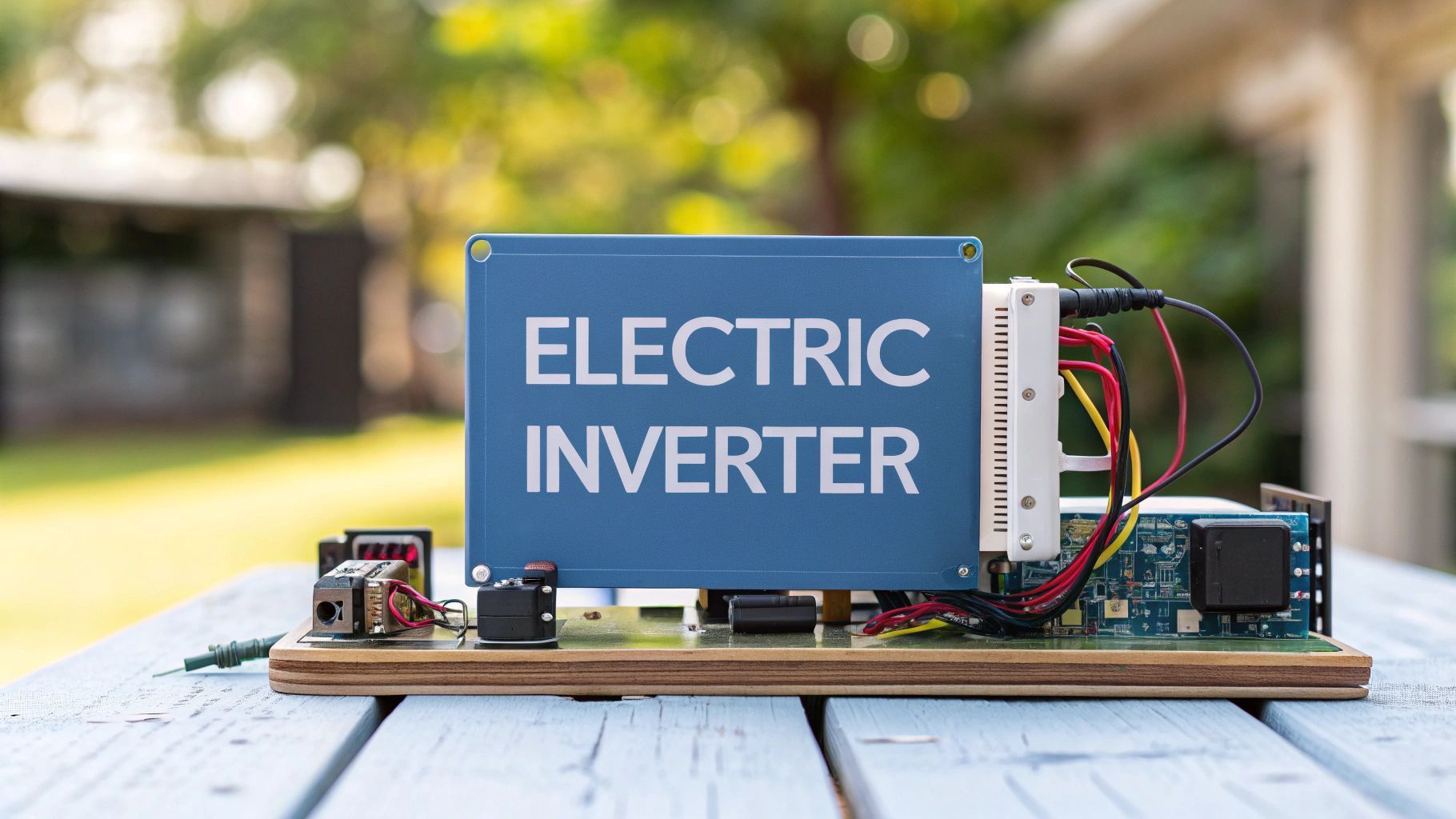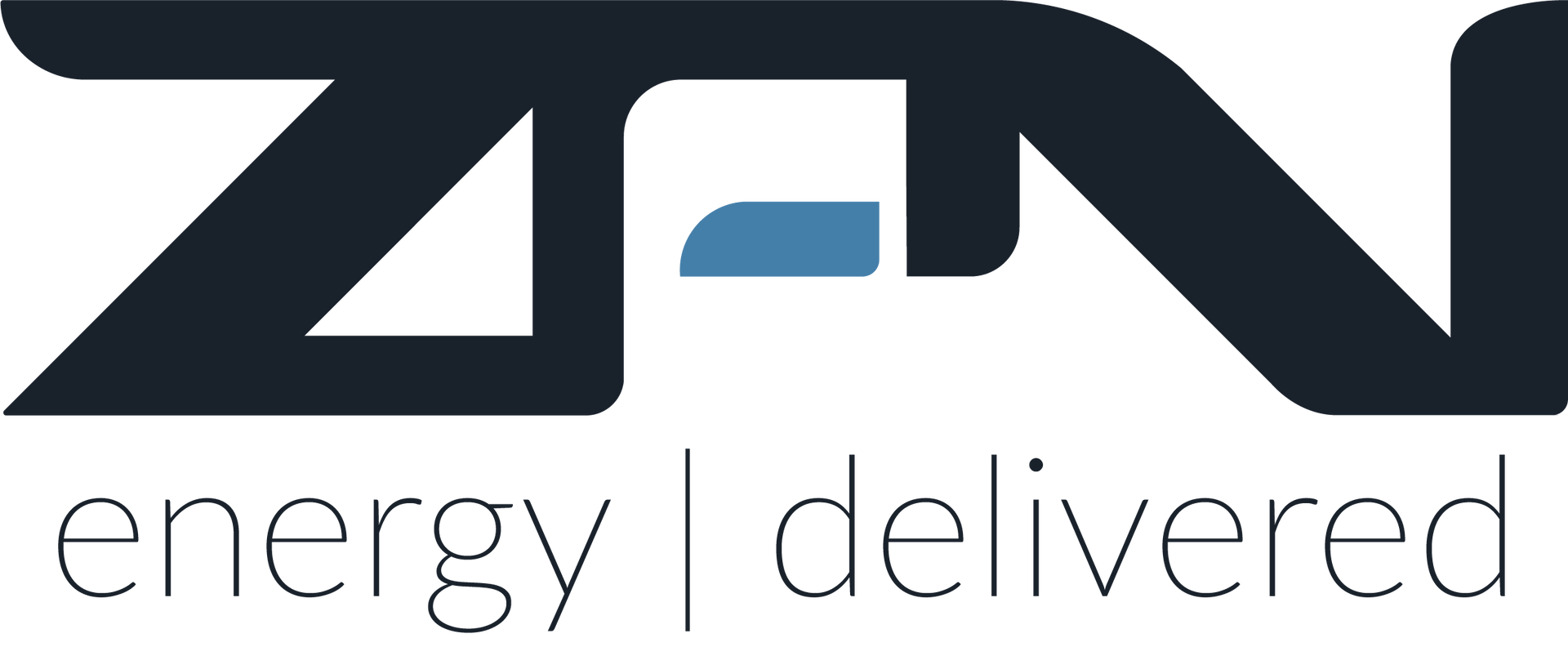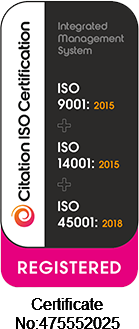Energy Meter Siemens: Your EV Charging & Grid Management Guide
Siemens energy meters are the backbone of any modern power management setup, particularly when you're dealing with the demands of EV charging, grid scale batteries or combined on site renewables . These smart devices are what give you the granular data needed for things like dynamic load balancing and intelligent power distribution, especially when you're up against the limits of a constrained grid connection. They are, in essence, the brains of the operation.
Why Siemens Energy Meters Are Vital for Modern Power Systems
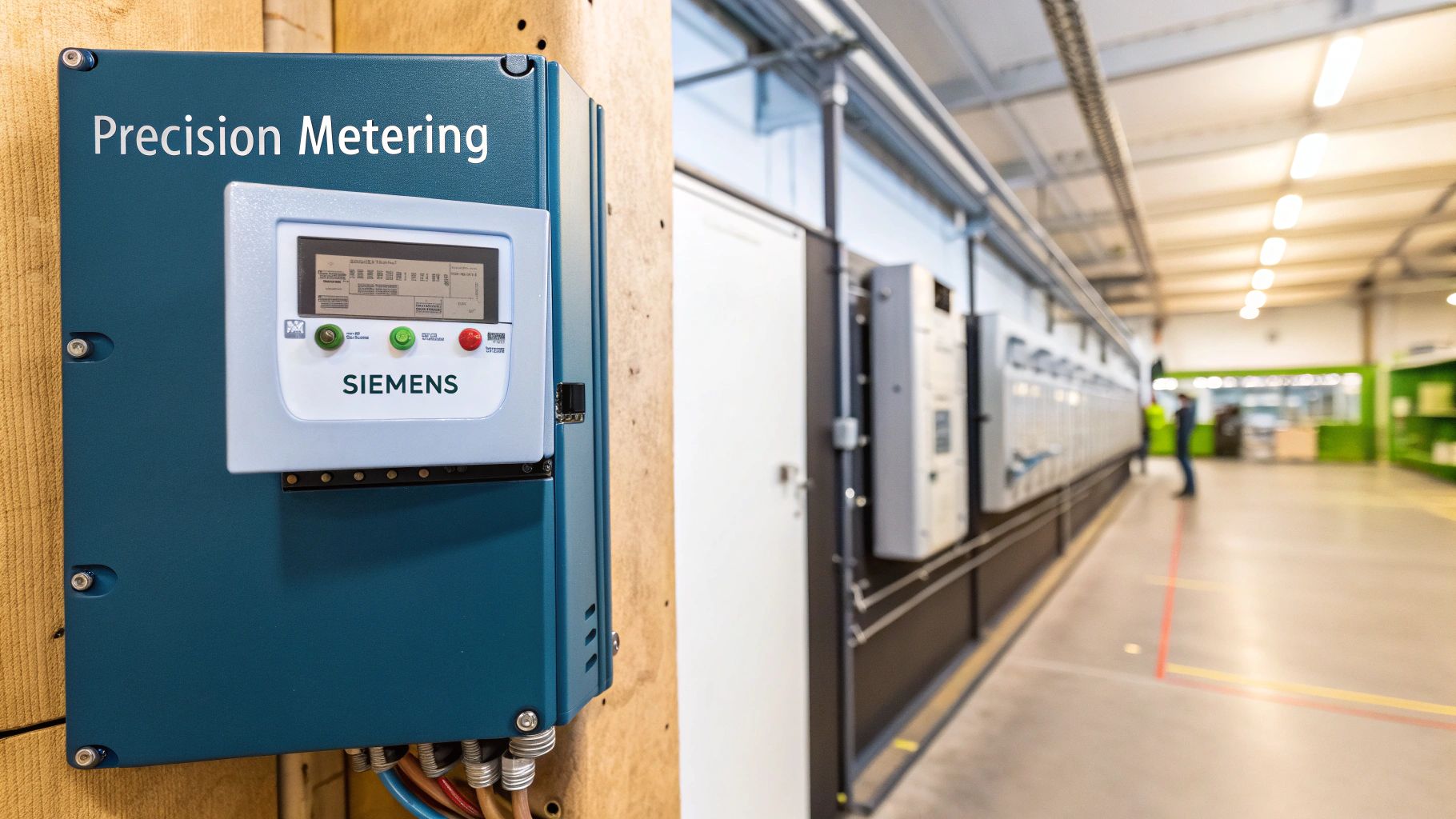
In the old days, a meter's job was simple: just clock up the total consumption for the monthly bill. But that is a world away from where we are now. The explosion in electric vehicles and on-site renewables like solar has thrown a whole new set of challenges at our power grids. An advanced energy meter siemens device is not just a passive counter anymore; it is an active, critical component of your distributed energy strategy.
Think of it as the control centre for your entire electrical system. It is constantly feeding you the high-resolution, real-time data you need to make smart decisions about where your power is going. This is absolutely crucial for sites with limited grid capacity that are trying to handle power-hungry assets like rapid EV charging hubs.
Navigating Constrained Grid Connections and EV Charging
Let's face it, most commercial and industrial sites were never built to handle the massive power draw of a bank of rapid EV chargers. A constrained grid connection can quickly become a major bottleneck, slamming the brakes on expansion plans and frustrating drivers with unavailable charge points. This is exactly where a Siemens meter proves its worth.
By precisely monitoring the site's total energy consumption, moment by moment, the meter enables a system to perform dynamic load balancing . This simply means the power going to the EV chargers can be automatically dialled up or down to ensure you never trip the main breaker. It is the key to maintaining operational stability without forking out for eye-watering grid upgrade costs. For a deeper dive into this, check out our guide on grid energy management.
Uniting On-Site Renewables, EV Charging and Batteries
Bringing your own on-site renewables into the mix adds another layer of complexity. To get the most out of your solar panels and reduce your reliance on grid power, you need to know exactly when you're generating a surplus and when you're pulling from the mains, especially when managing grid scale batteries.
A smart meter acts as the central data hub, orchestrating the flow of energy between your solar panels, grid scale batteries, EV chargers, and the grid. It makes sure that the clean power you generate on-site is used efficiently or stored for when you need it most.
This capability is the foundation of modern, distributed energy systems. The government-backed smart meter rollout across Great Britain underscores this shift. By the end of Q1 2025, there were approximately 37 million domestic smart meters installed , with 66% of electricity meters running in smart mode. This nationwide push highlights just how important accurate, real-time energy monitoring is for building a more flexible and resilient grid. You can read the full government report about the rise of smart meters for more detail.
Choosing the Right Siemens Meter for Your Needs
Picking the right Siemens meter is not just about matching electrical specs. Think of it as choosing the right diagnostic tool for a very specific job. A single rapid EV charger has completely different data needs than a complex industrial site with grid-scale batteries and on-site renewables. The trick is to cut through the technical jargon and focus on what a meter can actually do for your distributed energy goals.
You will frequently come across two main product families: SENTRON and SIVACON . While both are built for serious energy monitoring, they are designed for different arenas. The SENTRON series, especially the PAC meters, are brilliant for detailed sub-metering—monitoring individual circuits, like a row of EV chargers. SIVACON components, on the other hand, are usually found inside larger, integrated power distribution systems.
The first step is always to get a clear picture of what you need to achieve. Is your main goal accurate billing for individual EV charging sessions from a constrained grid connection? Or do you need to monitor the overall power quality across your entire facility to safeguard sensitive equipment? Your answer will point you straight to the right model.
Core Features That Matter for EV Charging and Distributed Energy
When you're dealing with EV charging or on-site renewables, some features are simply non-negotiable. Pinpoint accuracy is essential for fair billing and for making split-second decisions about when to charge or discharge a grid scale battery system. Always look for meters that meet (or beat) the required accuracy class for your application.
Communication protocols are the other big piece of the puzzle. Your meter needs to be able to "talk" to your other systems, whether that is an EV charge point management system (CPMS) or a wider building management system (BMS).
- Modbus: A classic, reliable protocol that is perfect for straightforward data exchange between meters and control systems. It is a real workhorse.
- PROFINET: This is an industrial Ethernet standard that gives you much faster, real-time communication. It is vital for dynamic load management, especially in places with multiple rapid EV chargers firing up at once from a constrained grid connection.
It is these communication channels that turn a simple meter from a passive data collector into an active player in a smart grid, enabling real-time adjustments that boost performance and prevent system overloads.
The image below gives a great overview of the key features an engineer would look at when picking a Siemens meter for a specific job.
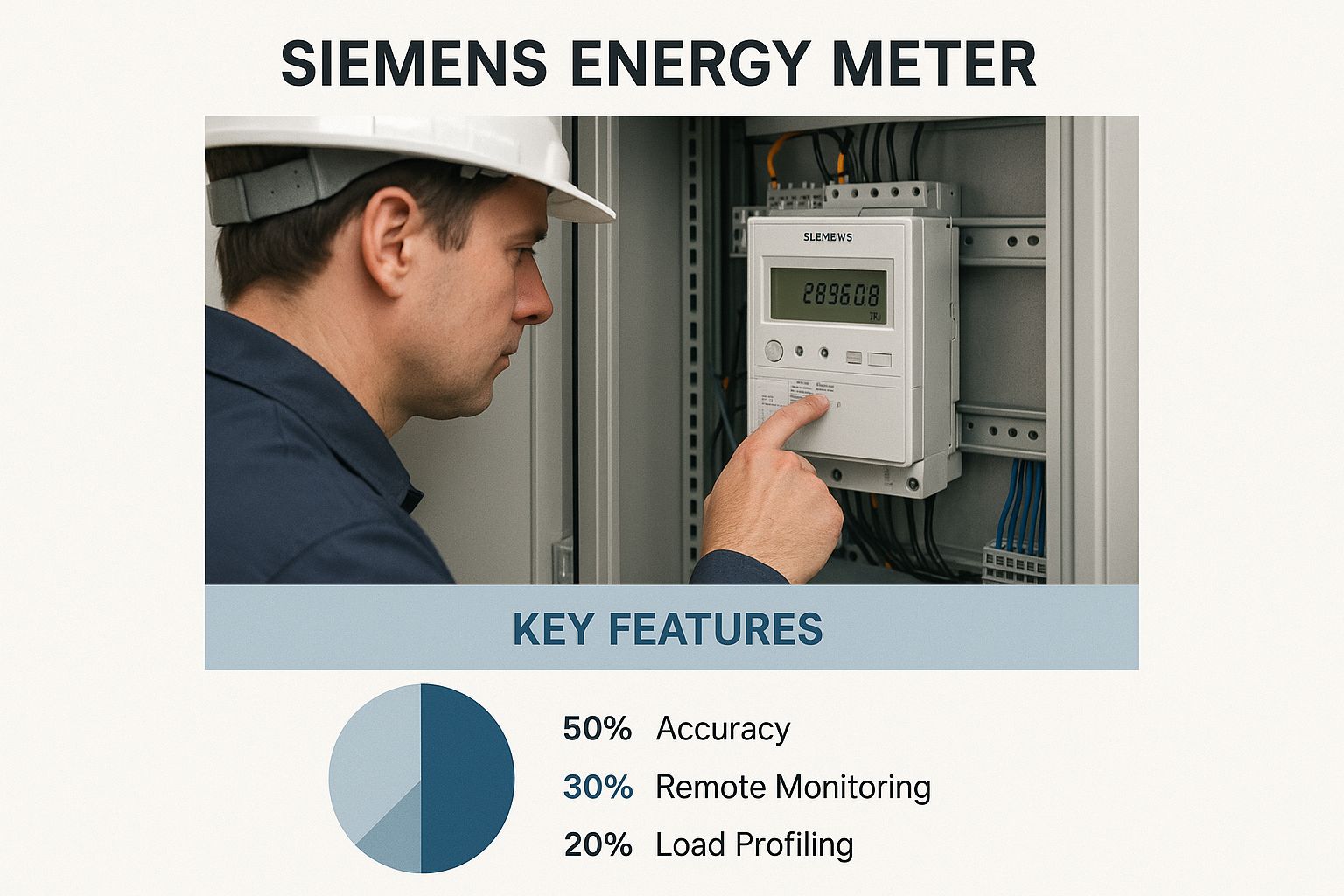
As you can see, it is all about matching the meter's capabilities—like communication type and power quality analysis—to the demands of the project, whether it is for a simple EV charger or a complex industrial control system managing grid scale batteries.
A Quick Look at Key Siemens Meter Models
To help make sense of the options, here is a breakdown of some popular Siemens series and where they fit best. This table compares their primary uses, features, and communication abilities, making it easier to see which one aligns with your needs for EV charging and renewable energy projects.
Siemens Energy Meter Model Comparison for Energy Management
| Model Series | Primary Application | Key Features | Communication Protocols |
|---|---|---|---|
| SENTRON PAC3200 | General sub-metering, individual circuit monitoring (e.g., EV chargers). | High accuracy, compact design, clear display, versatile digital inputs/outputs. | Modbus RTU/TCP, PROFIBUS DP |
| SENTRON PAC4200 | Advanced monitoring for facilities with renewables, grid scale batteries and EV fleets. | Full power quality analysis (harmonics, sags), event logging, high-end accuracy. | Modbus TCP, PROFINET, BACnet IP |
| SENTRON 7KM PAC2200 | Basic energy monitoring for smaller commercial sites or simple load management. | Direct measurement up to 65A, MID certified for billing, basic data logging. | Modbus RTU, M-Bus |
Choosing the right series comes down to balancing current needs with future-proofing. The PAC3200 is a fantastic all-rounder, but the PAC4200 provides the deep diagnostic data needed to manage more complex, dynamic energy systems.
Matching the Meter to the Application
Let's put this into a real-world context. For a mobile EV charging unit, a compact and tough meter with simple Modbus communication is probably the perfect fit. It gives you the billing and basic monitoring data you need without overcomplicating things.
But what about a large bus depot with its own solar farm and a huge grid scale battery system? That is a different beast entirely. Here, a high-end SENTRON PAC meter with power quality monitoring is not a luxury; it is a necessity. This feature allows you to spot problems like voltage sags or harmonic distortions that could easily damage expensive rapid EV chargers. It provides the deep insights you need to juggle the complex energy flows between solar panels, battery storage, and a fleet of rapid chargers, all while dealing with a constrained grid connection.
This level of capability is why Siemens Energy Ltd is such a dominant force in the UK's Electricity Distribution & Control Apparatus Manufacturing sector, which is forecast to generate around £491.7 million in revenue in 2025. This market position is built on delivering the advanced metering needed to modernise the UK's power grid. You can find more data on the UK's energy control apparatus market on ibisworld.com.
The "best" energy meter Siemens offers is not always the most expensive one. It is the one that delivers precisely the data and communication capabilities your specific distributed energy ecosystem needs to run smoothly and efficiently.
Getting this choice right from the start gives you a solid, future-proof foundation. It means you can not only manage your current assets effectively but also scale up easily, whether that means adding more rapid EV chargers, expanding your grid scale battery storage, or even participating in grid services down the line.
How Siemens Meters Make Smart EV Charging a Reality
This is where the rubber really hits the road—where the technical capabilities of an advanced energy meter solve the real-world challenges of EV charging. Think of a Siemens energy meter as the brain behind the brawn. It transforms a simple EV charging setup into a smart, responsive system that does not just measure power, but actively manages it. This is absolutely critical for any business juggling the boom in EVs with the reality of a constrained grid connection.
The secret sauce here is dynamic load management .
Picture a busy commercial depot during peak hours. You have got multiple rapid EV chargers powering up a fleet, heavy machinery running, and the building's air conditioning working hard. Without a smart system in place, that is a recipe for an overload, tripping the main breaker and grinding your entire operation to a halt.
A Siemens meter is the key to avoiding that chaos. It acts as a vigilant watchdog, providing a constant, real-time feed of the site's total electricity use. This data is the lifeblood for any intelligent charging system.
A Day in the Life of a Depot
Let's break down how this works in practice. We install a Siemens meter right at the main electrical incomer for the depot. From this strategic position, it measures every amp being pulled from the grid and feeds that information—usually via Modbus or PROFINET—to the EV charging management software.
The software knows the maximum load the site can handle; it is a hard limit you cannot exceed. As drivers plug in and their vehicles begin to charge, the software keeps a close eye on the data streaming from the Siemens meter. If the total site consumption gets dangerously close to that pre-set limit, the system instantly and automatically throttles back the power going to the EV chargers. It can share the reduced capacity fairly among all vehicles or prioritise specific chargers based on your own rules.
This is not just a crude on/off switch. It is a smooth, dynamic balancing act. The system ensures you never breach your grid capacity while squeezing every available kilowatt out to charge the vehicles as fast as safely possible.
This level of precise control is a game-changer. It means you can often install more chargers than your constrained grid connection would normally allow, maximising your site's capacity without facing the massive cost and long delays of a grid upgrade. It turns a potential problem into a smartly managed asset.
Taking Smart Charging on the Road
The same logic of precision measurement and control is vital for the emerging field of mobile EV charging . These are the units you see at festivals, construction sites, or as temporary roadside assistance where fixed chargers are not an option. Power for these units might come from a temporary grid hook-up or, more commonly, an on-board battery system.
In these scenarios, a built-in Siemens meter is non-negotiable for a few key reasons:
- Accurate Billing: It meticulously tracks every kilowatt-hour delivered to a vehicle. This guarantees fair, transparent billing for customers in a pay-as-you-go setting.
- Battery Efficiency: When you're running on battery power, every watt is precious. The meter helps the system manage the power draw to charge as many vehicles as possible before the battery itself needs a top-up.
- Protecting the Hardware: It constantly monitors the output, preventing overloads that could fry the mobile unit’s expensive internal components or damage the battery pack.
This fine-grained control is what makes mobile EV charging and off-grid charging a reliable and profitable business. When paired with energy storage, it creates a completely self-contained charging solution. To see how this synergy works, you can explore the benefits of battery-backed EV charging and its role in sidestepping grid constraints.
At the end of the day, whether you're running a fixed rapid EV charging hub or a fleet of mobile units, the Siemens energy meter is the component that unlocks safe, efficient, and scalable EV charging. It provides the solid, data-driven foundation you need to manage power intelligently, ensuring your operation is both reliable and profitable.
Integrating Renewables and Battery Storage
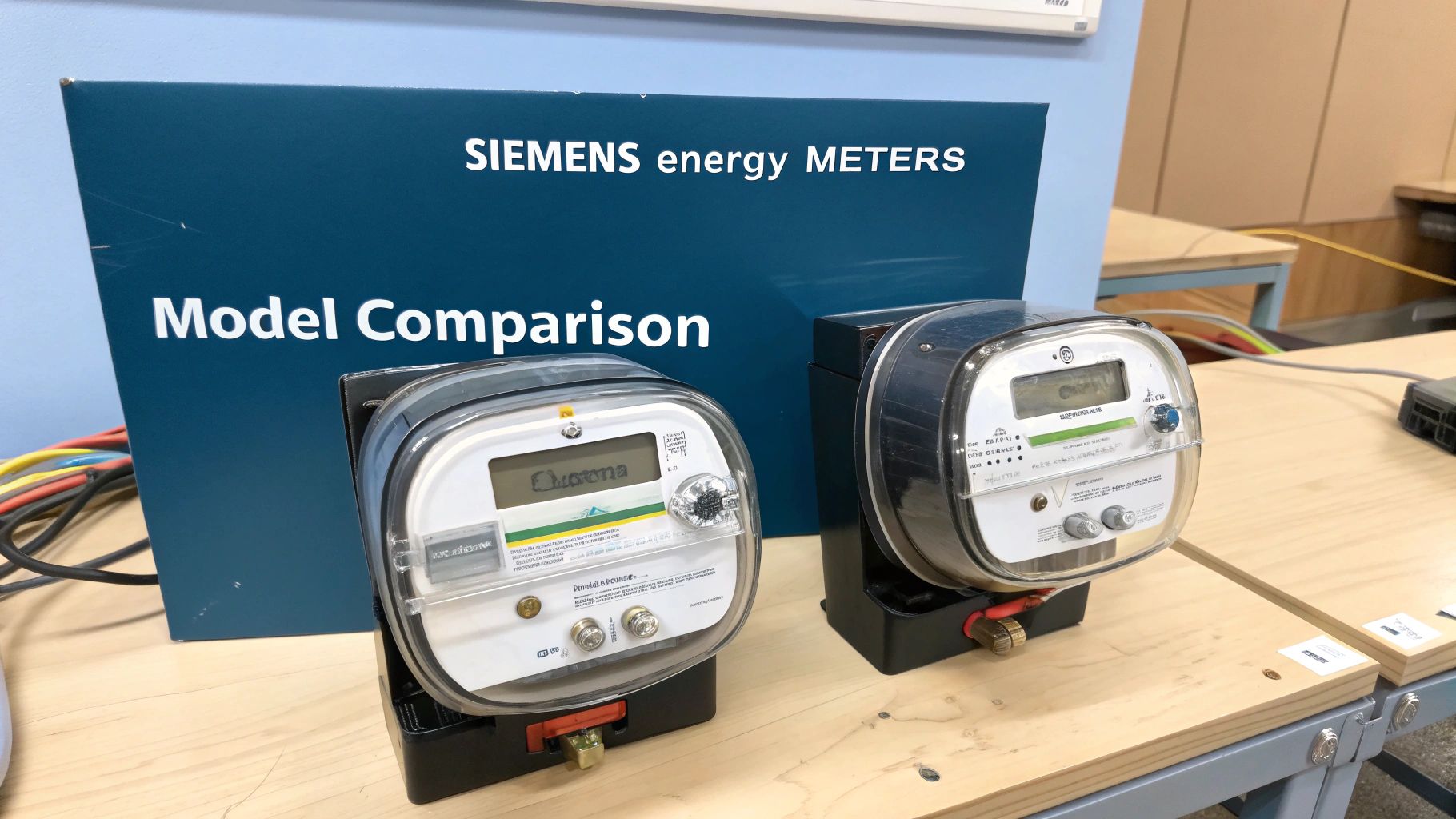
So far, we have focused on how Siemens meters manage EV charging, but that is really just scratching the surface. A high-quality energy meter siemens device is the central nervous system for a complete on-site distributed energy ecosystem, especially one that brings together combined on-site renewables like solar and grid scale batteries.
Think of it as the conductor of an orchestra. It ensures the solar panels, batteries, and rapid EV chargers are all playing in perfect harmony.
This integration is where you see the real magic of smart energy management happen. The meter’s ability to measure energy precisely, in real-time, and in both directions is what makes it all possible. It does not just track what you pull from the grid; it also measures every kilowatt of surplus energy you generate, whether you send it back to the grid or store it in your grid scale batteries for later.
This capability completely changes the game. It transforms a site from being a simple energy consumer into a flexible asset that can actively support a constrained grid connection. It is the key to wringing out every last drop of efficiency and even opening up new revenue streams from your energy infrastructure.
The Symphony of Energy Flow
Let’s picture a typical commercial site. There is a large solar array on the roof, a hefty battery energy storage system (BESS), and a bank of rapid EV chargers in the car park. Right at the heart of it all is a Siemens meter, constantly watching the flow of electricity between these components and the national grid.
Here is how it might orchestrate a typical day:
-
Morning Solar Generation: The sun comes up, and the solar panels start producing power. The Siemens meter immediately spots this and tells the energy management system (EMS) to use this free, clean energy first—powering the building and any EVs that are already plugged in.
-
Storing Surplus Energy: By midday, the panels are often generating more electricity than the site needs. The meter identifies this surplus and instructs the EMS to channel it straight into the grid scale battery, effectively bottling that sunshine for later.
-
Evening Peak Demand: As the workday ends, employees head to their cars and plug in, causing a huge spike in demand just as the sun is setting. Instead of pulling expensive peak-rate electricity from the grid, the meter signals the EMS to discharge the battery, using that stored solar power to fuel the chargers.
This intelligent coordination is what separates a basic setup from a truly smart one. It slashes reliance on the grid, cuts energy costs dramatically, and shrinks the site's carbon footprint. The ability to seamlessly blend different energy sources is a cornerstone of modern distributed energy systems. You can learn more about integrating renewable energy with advanced storage solutions to see exactly how these systems are designed.
Beyond Cost Savings: A Grid-Supportive Asset
This level of control does more than just save you money on bills. It turns the entire site into a dynamic asset that can help stabilise the grid, which is particularly useful when the local connection is under strain. By storing energy when demand is low and releasing it during peaks, the site helps to smooth out the load on the wider network.
The Siemens meter provides the verified, high-resolution data needed to participate in grid services like demand response. This allows the site to earn revenue by helping the grid operator maintain stability.
This function is becoming absolutely critical as more renewables are connected to the national grid. The growing appetite for these smart systems is clear from the market's expansion. In the UK, the energy management systems market, which includes devices like the energy meter siemens , was valued at around USD 2.9 billion in 2024 and is projected to hit USD 5.6 billion by 2030. This growth is fuelled by the urgent need to improve energy efficiency and manage distributed energy resources.
Here's the rewritten section, designed to sound completely human-written and natural.
A Practical Checklist for Your Project
Choosing the right Siemens energy meter is not just a technical detail; it is a decision that underpins your entire energy management strategy. A good choice opens the door to efficiency and easy expansion down the road. The wrong one can create data bottlenecks and seriously stunt your project's growth.
This is not about getting lost in spec sheets. It is about matching the right tool to the job. By walking through these key points, you can be confident the meter you pick is a perfect fit for your rapid EV charging, combined on-site renewables, or grid scale battery project.
Electrical System Compatibility
Before you even think about fancy features or software integration, you have to nail the basics. The meter absolutely must be compatible with your site's electrical system. This is the first, non-negotiable step. Get this wrong, and nothing else matters.
- System Type: Is it a single-phase or three-phase system? This is the most fundamental question to answer.
- Voltage and Current Ratings: Check that the meter’s operating range can handle your system's voltage and, just as importantly, the maximum current you expect. Do not just plan for today—think about future loads from new EV chargers or other equipment.
- Installation Method: Where is it going? A meter designed for a DIN rail inside a control panel is physically different from one built for direct connection.
Data and Communication Requirements
A smart meter is only as smart as the information it can share. This is especially true when you're juggling the dynamic loads of EV chargers from a constrained grid connection or trying to get your meter talking to a building management system.
Think about what needs to hear from the meter. Is it just feeding a local display, or does it need to send real-time data to a cloud platform for remote monitoring and billing?
Think of the communication protocol as the language your meter speaks. Picking a meter with the wrong protocol is like hiring a brilliant specialist who cannot speak the same language as the rest of your team. Communication just breaks down.
- Required Protocols: Do you need something robust and simple like Modbus, or do you require the high-speed communication of PROFINET for real-time dynamic load management with rapid EV chargers?
- Integration Points: Make a list of every single system the meter needs to connect with. This could include EV charging software, grid scale battery controllers, building automation systems, or third-party billing platforms.
Future-Proofing Your Investment
Your energy needs are going to change. With the boom in EV adoption and the falling cost of battery storage, what works today might be a bottleneck in five years. A Siemens energy meter is not a disposable component; it is a long-term investment in your infrastructure.
Think about how your site might evolve. Are you planning to add more rapid EV chargers? Is a large-scale grid battery a future possibility? Picking a meter with room to grow saves you from a costly and disruptive replacement later on.
- Scalability: Always choose a meter that can handle higher loads than you currently have. A little extra capacity now is cheap insurance for the future.
- Advanced Features: Does the meter offer power quality monitoring? You might not need it today, but as your site's electrical profile gets more complex with combined renewables and multiple chargers, it becomes an invaluable tool for troubleshooting.
- Firmware Updates: Check if the meter’s firmware can be updated. This gives you a path to support new features or communication protocols as technology evolves, making your system far more adaptable.
Future-Proofing Your Energy Infrastructure
Putting an advanced Siemens energy meter into your system is more than just a simple upgrade. Think of it as laying the cornerstone for a smarter, more resilient energy future. These devices are what make a distributed energy grid possible—a grid where power is generated, stored, and used right where it is needed.
They provide the crystal-clear data essential for juggling complex assets like rapid EV chargers, solar panels on the roof, or large-scale battery storage. This ensures every piece of the puzzle works together seamlessly.
This shift in thinking turns a building from a passive electricity user into an active, nimble player on the wider energy network. Picking the right metering technology today is the single most important step you can take to get ready for the challenges—and opportunities—of tomorrow.
The Next Wave of Energy Management
The job of a high-quality Siemens energy meter is about to get a lot bigger. We are heading towards an energy landscape that is far more interactive and predictive, and that world runs on precise data. The next chapter in energy management will be all about deeper integration and smarter automation, particularly for EV charging and grid scale batteries.
Here are a few key applications just around the corner:
- Vehicle-to-Grid (V2G) Technology: V2G lets electric vehicles do more than just charge; they can feed power back into the grid when it is needed most. This entire concept hinges on accurate, bi-directional metering to verify the energy returned and make sure the EV owner gets paid for it.
- Demand-Response Programmes: Grid operators are increasingly asking large energy users to dial back their consumption during peak times to help balance the grid. Siemens meters provide the verified, trustworthy data your site needs to participate in these programmes, turning your energy flexibility into a revenue stream.
- AI-Driven Energy Platforms: The future is all about prediction. AI platforms will digest the rich data from your meters to forecast energy needs, anticipate how much your solar panels will generate, and optimise when your grid scale batteries charge—all to squeeze out every last drop of efficiency and cost savings.
Choosing a meter that can handle these future applications is crucial. It is about building a system that is not just efficient today, but is ready to adapt to the much smarter grid that is on its way.
To truly future-proof your energy setup, it is also wise to use robust climate risk assessment tools that can pinpoint vulnerabilities and guide your long-term planning. By marrying precise energy data with a forward-looking view of potential risks, you create a distributed energy strategy that is genuinely built to last. The Siemens energy meter is the perfect starting point for that journey.
Frequently Asked Questions
When you're getting to grips with advanced energy metering, a few questions naturally pop up. Let's tackle some of the most common ones we hear about using a Siemens meter for things like rapid EV charging, grid scale batteries, and combined on-site renewables.
Can I Use a Siemens Meter with Other Brands of EV Chargers?
Yes, absolutely. One of the best things about Siemens energy meters is that they are built on open communication protocols. This is not a closed-off system. Most quality EV chargers and their management software are designed to work with industry standards like Modbus or PROFINET .
Think of it as a common language. As long as your charger and its control software can "speak" the same language as the meter, they can work together seamlessly. The meter’s job is to be the honest broker, providing rock-solid, real-time energy data. The charging system then uses that data for everything from dynamic load management to customer billing, no matter who made the charger itself.
What Is the Main Difference Between a Basic and an Advanced Meter?
The real difference boils down to the richness of the data and how well it communicates. A basic meter is pretty much just a billing tool; it does a good job of counting the total kilowatt-hours you have used over a period.
An advanced model, like a Siemens SENTRON PAC4200 , is in a different league entirely. It gives you a much more detailed, granular picture of your energy use. This includes:
- Power Quality Monitoring: It keeps an eye out for issues like voltage dips or harmonic distortions that can damage sensitive kit like rapid EV chargers or inverters.
- Real-time Data Streams: With high-speed communication over protocols like PROFINET, it provides the instant feedback needed for effective dynamic load management, especially from constrained grid connections.
- Detailed Logging: It records energy profiles and electrical events, giving you the data you need to fine-tune your system's performance and track down any faults.
It helps to think of it this way: a basic meter tells you how much energy you used last month. An advanced meter tells you exactly how you're using energy right now and warns you about problems before they happen.
How Does a Siemens Meter Support a Mobile EV Charging Unit?
For any mobile EV charging or temporary EV charging setup, a Siemens meter is a game-changer for making it work efficiently and profitably. Its precise measurement ensures every single charging session is logged accurately, which is fundamental for billing customers correctly.
Beyond billing, if the mobile EV charging unit runs on an onboard battery, the meter is crucial for managing the power draw. It prevents overloads that could wreck the battery or the charging hardware, and helps you get the maximum number of charges out of a single battery cycle. It is what makes the whole mobile EV charging operation both reliable and commercially sound.
At ZPN Energy , we build high-precision metering right into our rapid EV charging and battery storage solutions to deliver robust, intelligent energy management. To see how our systems can future-proof your infrastructure, have a look at what we do at ZPN Energy.


